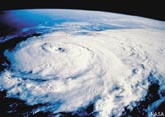
|
|
GOES Calibration
|
GOES Calibration
- How are the Imager and Sounder aboard the GOES satellites
calibrated? Read our Technical Memorandum! Take a
look at the Operational
Calibration Text.
- A paper is now in the literature! Look at the September
20, 1997 issue of APPLIED OPTICS. The citation is:
Weinreb, M.P.,M. Jamison, N. Fulton,
Y. Chen, J.X. Johnson, J.
Bremer, C. Smith, and J. Baucom,
1997: Operational calibration
of Geostationary
Operational Environmental Satellite-8
and -9 imagers and
sounders. Applied Optics,
36, pp 6895-6904.
- GVAR Data Rollover in Channel 2 of
GOES-12 Imager (pdf file)
- A presentation entitled Correction for
GOES Imager Midnight Blackbody Calibration Error
- Important Information: Correction for GOES imager
midnight calibration errors
- Implementation of Midnight Blackbody Calibration Correction (MBCC)
- Important Information: Change
of channels on imagers beginning with GOES-12
-
Learn about star-based imager visible channel responsivity trending!
- Learn about pre-launch calibration of
the visible-channel data!
-
Post-launch MODIS-based vicarious calibration for the GOES-10 through -15 Imager visible channel.
- Learn how to convert GVAR
counts to temperature in the infrared channels!
- Post-Launch vicarious
calibration of visible channel of GOES-8 and 10 Imager
Go here to make sure you are using the most recent spectrual response
functions available for each instrument.
How are the detectors behaving on the Imager and Sounder? Let's
take a look at two representative samples.
- GOES-8
Imager Channel 4 Detector 1(plot)
- Ever since the summer of 1994, we have been monitoring
responsivities of each imager IR detector. With the patch
temperature set at 101 oC degrees, the slope
(inverse of the responsivity) trended at about -0.23. In
August, 1994 the patch temperature was lowered to 94 oC
degrees. At a colder temperature, the absolute value of
the slope decreases as seen in the plot. In April 1995,
SOCC introduced a scan mirror emissivity correction to the
calibration algorithm, and a change in slope was observed.
In the summer months of 1995 - 1998, the patch was maintained
at 101 oC degrees. The slope is stable near -0.22.
During all other months of the year the patch is controlled
at 94 oC degrees, operating with a stable slope
near -0.18.
- GOES-8
Sounder Channel 8 Detector 1(plot)
- Monitoring efforts for the GOES-8 Sounder started in the
summer of 1994. Initially the detector patch was controlled
at 101 oC degrees. In August 1994, the patch
temperature was lowered to 94 oC degrees, and
has remained at that temperature since. In October 1994,
the first sounder decontamination was done for a 48-hour
period to drive off contaminants from the cooler housing
window. Starting in December 1994, we began a weekly decontamination
effort which runs for a 24-hour period each week to slow
the contamination process. This weekly process usually runs
until the end of April when the cooler housing temperature
gets hot enough to drive off contaminents without additional
heating sources. The large rise in slope centered around
Quarter 3 (Q3) is associated with the fluctuation in patch
temperature during the summer months.
Home | Operations |
News | Daily Updates |
Info & History
GOES | POES |
DMSP | Contact Us |
Internal
Webmaster
Privacy Policy
|
|
 |


 DOC
NOAA
NESDIS
DOC
NOAA
NESDIS



 DOC
NOAA
NESDIS
DOC
NOAA
NESDIS
